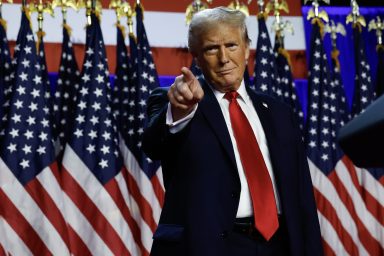The Impact Of Trump Administration Pressure On European AI Rulemaking

Table of Contents
Trade Tensions and the Threat of Retaliation
Trade disputes between the US and EU under the Trump administration created considerable pressure on the EU to avoid overly stringent AI regulations. The threat of retaliatory tariffs or trade restrictions loomed large, influencing the EU's decision-making process regarding AI governance. This transatlantic tension directly impacted the development of AI policy within the EU.
- Examples of specific trade disputes: The steel and aluminum tariffs imposed by the Trump administration, along with ongoing disputes related to aircraft subsidies (Boeing vs. Airbus), created a climate of uncertainty and potential retaliation. These disputes served as a backdrop against which the EU considered the economic ramifications of robust AI regulation.
- Economic leverage and influence: The US, as a major trading partner and significant player in the global AI market, wielded considerable economic leverage. The EU, mindful of the potential negative impacts on European businesses and exports, had to carefully weigh the benefits of strong AI regulation against the risks of trade retaliation.
- Concerns within the EU: Many within the EU expressed concern that overly stringent regulations could stifle innovation and place European businesses at a competitive disadvantage relative to their US counterparts. This concern fueled internal debates about the appropriate level of AI regulation.
Differing Approaches to Data Privacy and AI Governance
Fundamental differences between US and EU approaches to data privacy formed a major point of contention, significantly impacting the EU's AI strategy. The EU's General Data Protection Regulation (GDPR), with its emphasis on user consent and data protection, stands in stark contrast to the less stringent regulatory environment in the US.
- GDPR vs. US data protection frameworks: The GDPR's broad scope and stringent requirements regarding data collection, processing, and transfer created a significant hurdle for transatlantic data flows. This difference in approach fueled concerns within the EU about the potential for data breaches and misuse of personal information in AI systems.
- Impact on EU AI regulations: The differing approaches to data privacy directly shaped the design and scope of proposed EU AI regulations. The EU had to find a balance between protecting individual rights and facilitating AI innovation in a global market.
- Transatlantic data flows and AI development: Concerns regarding transatlantic data flows and the potential impact on AI development led to discussions about the need for harmonization or mutually acceptable frameworks to facilitate data exchange while protecting privacy.
The Influence on the Development of the AI Act
The Trump administration's pressure, or the perceived threat thereof, significantly influenced the drafting and content of the EU AI Act. The EU sought to balance its regulatory ambitions with the need to maintain positive transatlantic relations and avoid trade conflicts.
- Specific provisions reflecting US pressure: While not explicitly stated, some provisions within the AI Act might reflect concessions made to address potential US concerns. For instance, certain aspects of the risk-based approach to AI regulation could be interpreted as an attempt to avoid overly burdensome restrictions that might hinder innovation.
- Balancing regulatory ambition with economic considerations: The EU faced a challenging task in balancing its ambitious goals for AI governance with the need to avoid alienating a major trading partner and potentially damaging its own economy. This balancing act is evident in the overall approach adopted in the AI Act.
- Long-term consequences of concessions: The concessions made in response to perceived US pressure may have long-term consequences for the effectiveness of the AI Act. A less stringent regulatory approach might limit the EU's ability to achieve its stated goals regarding AI safety and ethical considerations.
The Role of International Standards and Harmonization
During the Trump administration, there were limited attempts at international harmonization of AI regulations. This lack of coordination resulted in a fragmented regulatory landscape, posing challenges for innovation and cross-border data flows.
- Initiatives for aligning US and EU regulations: While some dialogues occurred, concrete initiatives to align US and EU AI regulations were limited during this period. The differing policy priorities and approaches to regulation hindered meaningful progress on harmonization efforts.
- Challenges in achieving international harmonization: The absence of a unified global framework for AI governance created challenges for businesses operating across borders and hindered the development of globally interoperable AI systems.
- Impact of fragmented regulatory landscapes: The fragmented regulatory landscape increases compliance costs for businesses and can create uncertainty for investors, potentially slowing down innovation and hindering the responsible development of AI technologies.
Conclusion
The Trump administration's policies, characterized by a focus on deregulation and aggressive trade practices, exerted considerable pressure on the European Union's efforts to create a robust framework for AI governance. The resulting EU AI Act reflects a complex interplay of regulatory ambition, economic considerations, and the need to navigate a challenging transatlantic relationship. While the EU has striven for a balanced approach, the lingering impact of this Trump Administration Pressure on European AI Rulemaking remains a critical factor shaping the future of AI regulation globally.
Understanding the impact of Trump Administration Pressure on European AI Rulemaking is crucial for navigating the increasingly complex landscape of international AI policy. Further research into the specific regulatory mechanisms and their global implications is vital for fostering responsible AI development and deployment.

Featured Posts
-
 Mississippi Deltas Vastness A Cinematographers Perspective From Sinners
Apr 26, 2025
Mississippi Deltas Vastness A Cinematographers Perspective From Sinners
Apr 26, 2025 -
 Stock Market Overview Dow Futures Reaction To Chinas Economic Measures
Apr 26, 2025
Stock Market Overview Dow Futures Reaction To Chinas Economic Measures
Apr 26, 2025 -
 Ai And Human Design An Interview With Microsofts Chief Designer
Apr 26, 2025
Ai And Human Design An Interview With Microsofts Chief Designer
Apr 26, 2025 -
 Will Ukraine Join Nato Trumps View And Geopolitical Ramifications
Apr 26, 2025
Will Ukraine Join Nato Trumps View And Geopolitical Ramifications
Apr 26, 2025 -
 Where To Invest A Map Of The Countrys Rising Business Centers
Apr 26, 2025
Where To Invest A Map Of The Countrys Rising Business Centers
Apr 26, 2025
